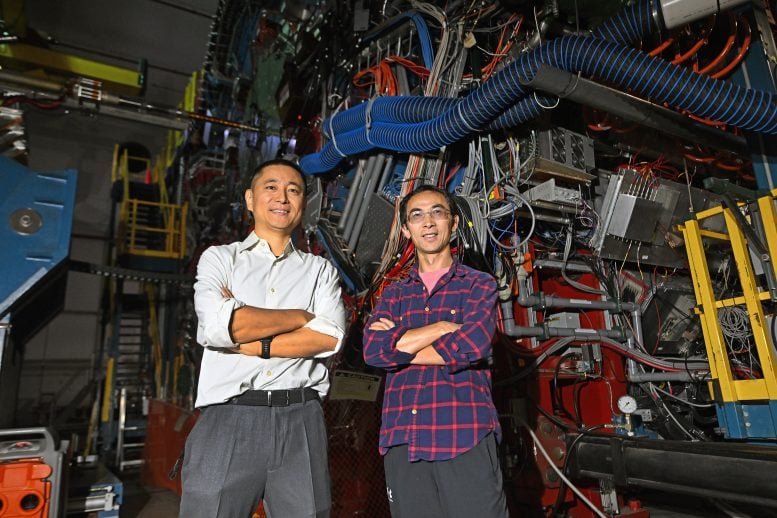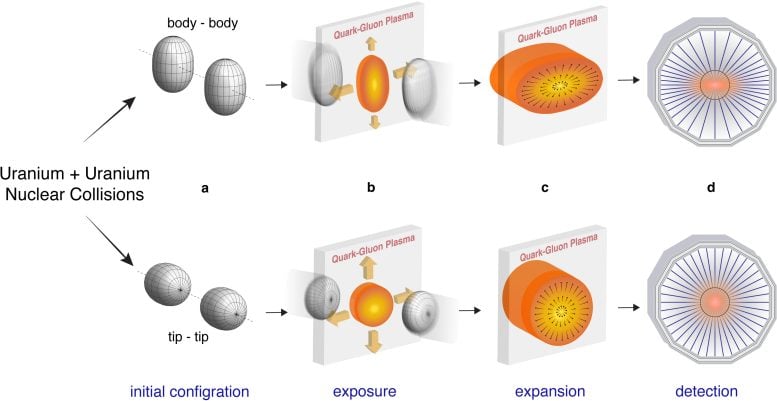Scientists employ high-energy heavy ion collisions as a powerful tool to uncover intricate details of nuclear structure, offering insights with broad implications across various fields of physics.
Scientists have developed a novel technique using high-energy particle collisions at the Relativistic Heavy Ion Collider (RHIC), a U.S. Department of Energy (DOE) Office of Science user facility for nuclear physics research located at DOE’s Brookhaven National Laboratory. Detailed in a newly published paper in Nature, this method complements lower-energy approaches for studying nuclear structure. It offers deeper insights into the shapes of atomic nuclei, enhancing our understanding of the building blocks of visible matter.
“In this new measurement, we not only quantify the overall shape of the nucleus — whether it’s elongated like a football or squashed down like a tangerine — but also the subtle triaxiality, the relative differences among its three principle axes that characterize a shape in between the ‘football’ and ‘tangerine,’” said Jiangyong Jia, a professor at Stony Brook University (SBU) who has a joint appointment at Brookhaven Lab and is one of the principal authors on the STAR Collaboration publication.
Deciphering nuclear shapes has relevance to a wide range of physics questions, including which atoms are most likely to split in nuclear fission, how heavy atomic elements form in collisions of neutron stars, and which nuclei could point the way to exotic particle decay discoveries. Leveraging improved knowledge of nuclear shapes will also deepen scientists’ understanding of the initial conditions of a particle soup that mimics the early universe, which is created in RHIC’s energetic particle smashups. The method can be applied to analyzing additional data from RHIC as well as data collected from nuclear collisions at Europe’s Large Hadron Collider (LHC). It will also have relevance to future explorations of nuclei at the Electron-Ion Collider, a nuclear physics facility in the design stage at Brookhaven Lab.
Ultimately, since 99.9% of the visible matter that people and all the stars and planets of the cosmos are made of resides in the nuclei at the center of atoms, understanding these nuclear building blocks is at the heart of understanding who we are.
“The best way to demonstrate the robustness of nuclear physics knowledge gained at RHIC is to show that we can apply the technology and physics insights to other fields,” Jia said. “Now that we’ve demonstrated a robust way to image nuclear structure, there will be many applications.”
From long exposure to freeze-frame snapshots
For decades, scientists used low-energy experiments to infer nuclear shapes — for example, by exciting the nuclei and observing photons, or particles of light, emitted as the nuclei decay back to the ground state. This method probes the overall spatial arrangement of the protons inside the nucleus, but only at a relatively long time scale.
“In low-energy experiments, it’s like taking a long-exposure picture,” said Chun Shen, a theorist at Wayne State University whose calculations were used in the new analysis.
Because the exposure time is long, the low-energy methods do not capture all the subtle variations in the arrangement of protons that can occur inside a nucleus at very fast timescales. And because most of these methods use electromagnetic interactions, they can’t directly “see” the uncharged neutrons in the nucleus.
“You only get an average of the whole system,” said Dean Lee, a low-energy theorist at the Facility for Rare Isotope Beams, a DOE Office of Science user facility at Michigan State University. Though Lee and Shen are not co-authors on the study, they and other theorists have contributed to developing this new nuclear imaging method.

“The high-energy imaging method, which captures many freeze-frame snapshots that reveal information about both the protons and neutrons, is orders of magnitude faster,” said Chunjian Zhang, a former SBU postdoctoral fellow, now a junior faculty member at Fudan University, who co-led the STAR analysis.
Importantly, the snapshots taken by RHIC’s STAR detector all come from different collision events.
“You cannot image the same nuclei again and again because you destroy them in the collision,” Jia noted. But by looking at the whole collection of images from many different collisions, scientists can reconstruct the subtle properties of the 3D structure of the smashed nuclei.
As Lee explained, “In each collision, you freeze time for a moment and look at where all the protons and neutrons are. And every time you do this, it’s a different distribution due to the quantum nature of atomic nuclei. So, the high-energy method captures a ton of information, a ton of complexity that we do not probe in low-energy experiments.”
Reconstructing shapes from debris
How exactly does STAR see that complexity if the nuclei get destroyed? By tracking how particles fly out — and how fast — from the most central, head-on nuclear smashups.
As the STAR scientists note in their Nature paper, “In an ironic twist, this effectively realizes [famous physicist] Richard Feynman’s analogy of the seemingly impossible task of ‘figuring out a pocket watch by smashing two together and observing the flying debris.’”
From years of experiments at RHIC, the scientists know that high energy nuclear collisions melt the protons and neutrons of the nuclei to set free their inner building blocks, quarks and gluons. The shape and expansion of each hot blob of this melted nuclear matter, known as a quark-gluon plasma (QGP), is determined by the shape of the colliding nuclei. The shape and size of each QGP blob directly affect pressure gradients generated in that blob of plasma, which in turn influence the collective flow and momentum of particles emitted as the QGP cools.
The STAR scientists reasoned they could “reverse engineer” this relationship to derive information about nuclear structure. They analyzed the flow and momentum of particles emerging from collisions and compared them with models of hydrodynamic expansion for different QGP shapes to arrive at the shapes of the originally colliding nuclei.

To show their method worked, they compared central collisions of gold nuclei — which are believed, from low energy studies, to be close to spherical — with central collisions of uranium nuclei, which have a pronounced elongated football-like shape. Because the gold nuclei are nearly spherical, there shouldn’t be much variation from collision to collision in the flow patterns of emitted particles.
“Central collisions of gold nuclei produce a circular, fixed size QGP that expands evenly in all directions,” said Shengli Huang, a SBU research scientist who co-led the STAR analysis. “The oblong uranium nuclei, on the other hand, can collide in a wide range of orientations, generating droplets of QGP with various shapes and sizes,” he said. So, the scientists expected central collisions of uranium to exhibit much more variability in the flow patterns.
This is what they observed.
By comparing measurements between uranium-uranium and gold-gold collisions — and fitting those results to hydrodynamic models that have successfully described other characteristics of the QGP — the scientists were able to infer a quantitative description of the shape of the uranium nucleus. The results also include a first determination of the relative lengths of the three principal axes of the oblong uranium nucleus.
Computing tools
Obtaining precision predictions from various hydrodynamic models, including Shen’s model, posed significant computational challenges. Accomplishing this task took over a year, with Zhang running calculations on the Open Science Grid. Zhang used more than 20 million central processing unit (CPU) hours to produce more than ten million collision events from hydrodynamic models, which were then fitted to the experimental data.
“Many features in the STAR data are indicative of the significant differences in the shape between the uranium and gold nuclei, but the computational data-model comparisons certainty helped us to more precisely quantify the nuclear shapes,” Zhang said.
Though this study aimed to establish a new nuclear imaging method, the data did reveal some new information about uranium nuclei. Instead of observing distortion in just the one principal axis that leads to “prolate” elongation, the scientists found differences in all three axes, suggesting that uranium nuclei are more complex than previously thought.
Expanded impacts
As noted, the new method will improve physicists’ understanding of the initial conditions in heavy ion collisions that generate QGP at both RHIC and the LHC. Nuclear structures derived from low-energy experiments were essential in analyses that linked those initial conditions with hydrodynamic flow patterns to establish that the QGP created in these collisions is a nearly perfect liquid. Scientists can now use the new method to check the consistency with low-energy approaches using nuclei like uranium where the structure is relatively well known. This will further reduce uncertainties about initial state conditions to improve the determination of QGP properties.
The method can also be used to determine shapes of other nuclei, especially those where the low-energy experiments yielded limited understanding. One example would be to apply the method to so-called isobar nuclei — nuclei with the same total number of protons and neutrons (nucleons), but different proportions of each type. Such pairs are involved when two neutrons in a higher-neutron-number “parent” nucleus transform into protons via a nuclear weak decay process to create the lower-neutron-number “daughter” — a process known as double beta decay. Knowing the shape differences between parent and daughter nuclei could help reduce model uncertainties in experiments searching for an unseen type of decay known as neutrinoless double beta decay.
“There are many interdisciplinary aspects of this research,” Jia explained. “Nuclear physics has many subfields. Usually, each community uses its own tools — theory and experiments. But because of these results, the low-energy nuclear structure and nuclear reaction communities around the world have taken notice. Several workshops, meetings, and conferences were organized to explore the connections between the high-energy and low-energy frontiers in nuclear physics, which allowed us to understand each other better,” he said.
Reference: “Imaging shapes of atomic nuclei in high-energy nuclear collisions” by STAR Collaboration, , 6 November 2024, Nature.
DOI: 10.1038/s41586-024-08097-2
This work was supported by the DOE Office of Science, the U.S. National Science Foundation (NSF), and a range of international agencies and organizations listed in the scientific paper. In addition to using the Open Science Grid, supported directly by NSF, the researchers made use of computing resources in the Scientific Data and Computing Center at Brookhaven Lab and the National Energy Research Scientific Computing Center (NERSC), which is another DOE Office of Science user facility at DOE’s Lawrence Berkeley National Laboratory.
This post was originally published on here







